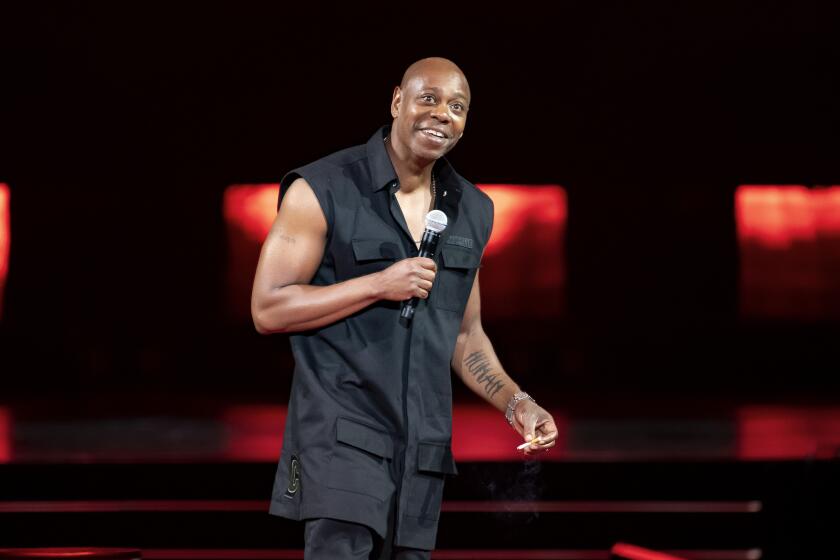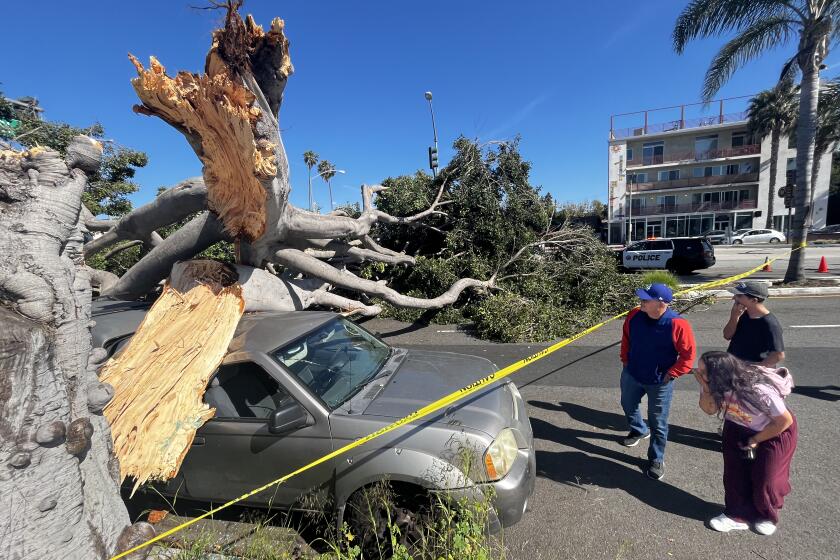Westwood Looks to Recapture Old Aura : Neighborhoods: Despite a weekend rampage by youths, merchants express confidence. They say a new plan can lure back adults who left as the village became a magnet for teen-age crowds.
For more than a decade, adult shoppers and the merchants who serve them have been abandoning Westwood Village, leaving behind a slightly shabby, but high-rent, commercial area out of sync with its surroundings--and filled with young people.
Ringed by sleek skyscrapers, the booming UCLA campus and opulent Holmby Hills mansions, the once-quaint village is now best-known as a weekend playground for the region’s teen-agers--the good, the bad and the dangerous.
Last weekend, the mix again proved volatile as hundreds of youths attracted to the village by an annual UCLA campus Mardi Gras carnival rampaged, smashing windows and looting stores along Wilshire Boulevard, authorities said.
University officials on Monday announced the formation of a committee to determine if the 50-year-old campus carnival should continue or be dramatically altered to avoid trouble next year.
“Mardi Gras was the magnet,” said City Councilman Zev Yaroslavsky, whose constituency includes Westwood. The councilman said an agitated crowd milling around the entrance to the charity event was herded off the campus when something sparked the disturbance. “The rest is history,” he said.
It’s the type of history Westwood Village has become famous for.
In March, hundreds of angry teen-agers broke windows and looted shops after being turned away from a sold-out premiere of the movie “New Jack City,” the story of a Harlem drug lord. The rioting led to renewed calls for the village theaters to stop showing violent movies that appeal to potentially unruly crowds.
Yaroslavsky said he is convinced that immediate steps must be taken to control late-night weekend crowds. One possibility, he said, would be to pressure Westwood’s 17 movie theaters to stop their midnight shows. “The pattern of late-night activity has to be broken up,” he said.
But, despite this most recent blot on Westwood’s image, the business community is not glum. On the contrary, even as shopkeepers swept up broken glass and surveyed their losses, they were upbeat about a plan to turn the village around.
In recent months, a newly reconstituted Westwood Village Assn. has, for the first time, started bringing merchants, homeowners and property owners into a coordinated group to address the community’s problems. On Monday, the volunteer leader of the association, Bill Knight, said he fielded many media calls, but no frantic calls from his merchants or homeowners, who are set on course for a major revamping of the area.
This planned makeover of Westwood Village is aimed at transforming it into an attractive outdoor gathering place, with convenient parking, al fresco dining, new outdoor furniture and landscaping.
The questions are: Will the thousands of shoppers and moviegoers, merchants and diners come back? Or will their frustration over barricaded streets, disturbances, parking problems and shoulder-to-shoulder 15-year-olds keep them away permanently?
THE PROBLEM: Some claim Westwood Village is a victim of its own allure. It offers movies and dining in one of the few pedestrian-friendly areas of the city. But as the age of the average moviegoer shifted downward and studios began marketing films to younger crowds, the village became a regional entertainment magnet for youths.
Fast-food outlets sprang up along with the theaters, further branding the area as a Mecca for teens. Few other businesses could match the fast-food shops’ ability to generate high revenue in minimal square footage. As leases expired and rents rose, more and more of the old neighborhood businesses--such as long-established clothing stores and dry cleaners--moved out.
Homeowner groups blame Yaroslavsky for the proliferation of fast-food restaurants. They say he allowed a zoning loophole to be inserted into the rules of temporary development moratorium in the mid-1980s.
Yaroslavsky, in turn, blames militant homeowner groups for stifling the village’s progress by holding up good projects with nitpicking complaints.
“You can’t fiddle while Rome is burning,” he said. “The Santa Monica (3rd Street) Promenade could go from the depths of despair to one of the most attractive places on the Westside while Westwood stood still.”
THE EXODUS: Ask longtime Westwood habitues about the ambience of the old village and they will tell of meeting for pizza at Mario’s, standing in line on New Year’s Eve to see “Love Story” or browsing at independently owned bookstores.
These same people have another memory--of the time they vowed they would never return on a weekend night.
“When I go out, I don’t need to go where my kids are,” said Gerald Breitbart, a Westside resident who runs the California Restaurant Assn. “There’s just nothing to drag me over there (to Westwood).” Breitbart said his attitude is prevalent enough that the village’s restaurants are suffering.
THE MOVIES: It was once impossible to see a new Woody Allen movie anywhere locally except Westwood. No more. Allen’s most recent movie, “Alice,” was first booked into the Century City AMC theater complex, a nearby adult refuge from Westwood’s adolescent movie crowd.
Moreover, most films now open in wide release and are shown at multiplex theaters that have popped up all over the Westside. In addition, theater complexes in the Beverly Center, Marina del Rey and, most recently, Santa Monica, have siphoned off the adult crowd.
“Westwood,” said Yaroslavsky, “has been beaten by some very sophisticated competition.”
CRIME: Police Capt. Michael Bagdonas says, and statistics bear him out, that the village is one of the safest areas in the city, with very little street crime.
The streets are now much safer than they were in the mid-’80s, Bagdonas said in an interview conducted before the Mardi Gras disturbance. Negative publicity, he said, is “basically destroying the village, and it’s unwarranted.”
On Monday, Bagdonas was in an all-day meeting and could not be reached for comment on the early Sunday morning looting which brought 10 arrests.
Yaroslavsky blamed the problem on campus officials who failed to heed a Los Angeles police warning that the event should close by 8 p.m., rather than remain open until midnight, with ticket sales stopping at 10:30 Saturday night. The event has been a powder keg for about three years, with a near-riot occurring two years ago, Yaroslavsky said.
But a university official cast the blame on what he described as a group of non-students who had not paid to attend the the festival and were outside their control. A Los Angeles Police contingent of more than 100 officers was unable to quell the disturbance for more than 90 minutes.
UCLA Campus Police Chief John Barber said Monday that his officers arrested 13 people, including two gang members with guns, and in one case, a felony record, over the weekend. The average weekend arrest toll for the campus is six or seven, Barber said.
Barber described the scene outside the Mardi Gras gates as a group of young people who had come in waves from the Federal Building parking lot on a shuttle bus provided for carnival-goers, but had not gone inside the event.
He said the youths came to the area because “that’s where the action was.” The problem arose as campus police moved the crowd off the campus in preparation for the Mardi Gras closing at midnight. Somewhere in the village, the situation turned sour.
Some Westwood Village crimes have attracted particular attention. In 1984, Danny Lee Young went berserk and ran down 48 people on the sidewalk with his car, one of whom died. In 1985, a UCLA student and her boyfriend were kidnaped and shot to death on Mulholland Highway after gang members commandeered their car outside her apartment.
In 1988, Karen Toshima of Long Beach was gunned down in gang cross-fire, a killing that came to epitomize fears that gang violence was spreading throughout the city.
Other disruptions have followed the openings of movies that draw large crowds of youths, but Yaroslavksy said there will be no effort to squelch showing of any type of movie. The crime issue, he said, has been “magnified beyond proportion.”
Laura Lake, who started Friends of Westwood in 1984 to address the changing village, applauds the plans to beautify and upgrade the village, but warned that unless the crime issue is addressed, Westwood could wind up being “Beirut with flowers.”
THE BARRICADES: A few months ago, orange-and-black bumper stickers appeared briefly in empty storefront windows. They said, “Out of business, thanks to Zev,” a criticism of the councilman’s support of barricades on the streets to discourage cruising.
The merchants are as upset as anyone about crime, but they are more upset about the solution--the barricades, introduced on Friday and Saturday nights in the early ‘80s.
“The barricades don’t keep gang members out. They keep out all of the affluent people that live in the neighboring towns,” said Gene Stratton, owner of Stratton’s Grill, in a recent letter to fellow business owners.
Stratton said his business dropped $300,000 a year after the barricades were introduced. Last year, police started erecting the barricades a few hours earlier, and business fell an additional $3,000 per Friday and Saturday, Stratton said.
Police like the barricades because they allow a relatively small number of officers to control the crowds. The barricades also are popular with homeowner groups.
Stratton said the merchants are working on an alternative plan to pay for a security patrol car in radio contact with store owners and the police. Recently, some merchants have predicted that the barricades would soon come down. Yaroslavsky, however, said earlier this month that there were no plans for removing them, although the hours might be altered.
MAKEOVER PLANS: The latest Westwood Village Specific Plan, a planning and zoning law enacted in 1989, stipulates that the city and property owners will jointly set up a management entity to oversee the village.
Not much progress has been made in two years, although an executive from the firm that oversees Santa Monica’s 3rd Street Promenade has been hired as a consultant for $50,000 to help get things moving. Yaroslavksy aide Marlene Bronson said she is guiding outdoor dining permits through the city bureaucracy, with street dining expected on Broxton Avenue by summer.
About complaints that the city has dawdled, Yaroslavsky said, “It really didn’t take that long. We’re moving rather fast.”
In an effort to improve parking, the Westwood Village Assn. is negotiating with UCLA for nighttime use of its new medical office building lot, just north of the village, said Knight.
Although Yaroslavsky has drawn much criticism from merchants and homeowners, the tone of discourse has been more conciliatory of late.
Elliott Lewis, a major village property owner, said he and others were galvanized into action by the “New Jack City” disturbance. “It was a spark that really united a tremendous amount of interest,” Lewis said. He is one of several people who praised Yaroslavsky for his responsiveness to the village.
Yaroslavsky, in turn, joins just about everyone in Westwood in praising Knight for energizing the village association.
Knight, a cheery optimist, says he perceives his job as one of motivating association members to “roll up their sleeves.”
“I told them they couldn’t rely on other people to do the job for them,” he said.
Westwood Village
Over the last decade, the Westwood Village core has evolved from a diverse commercial area to one with a heavy emphasis on entertainment. This has brought traffic congestion, a shortage of parking-and occasional riots and disturbances such as this weekend’s melee.
More to Read
Start your day right
Sign up for Essential California for news, features and recommendations from the L.A. Times and beyond in your inbox six days a week.
You may occasionally receive promotional content from the Los Angeles Times.





